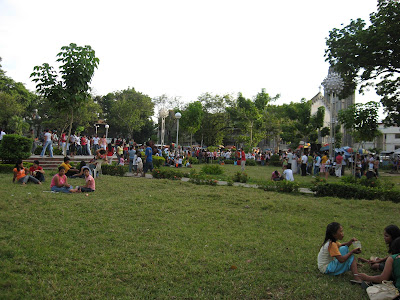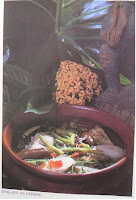Now the name for this region may be a bit of a misnomer because of the areas covered by the biggest region in the country. Here’s a geographical description of this area:
Region IV covers the southwestern part of Luzon and encompasses eleven provinces and several cities. It includes the provinces of Aurora, Batangas, Cavite, Laguna, Quezon, Rizal, and the island provinces of Occidental Mindoro, Oriental Mindoro, Marinduque, Romblon and Palawan. It is the largest region in the Philippines with a total land area of 9,940.72 sq.kms.
Definitely, not all areas covered could be considered Tagalog in the popular sense, of a people speaking the Tagalog dialect. The island provinces included definitely speak their own local dialects.
So how does the regional cuisine stand as a true representation of the entire region? Well, you get to decide for yourself.
SOPA DE POLLO
2 tablespoons cooking fat
1 clove garlic, minced
½ cup diced ham
½ onion, sliced
Gizzard, liver, blood, heart of one chicken, boiled and cut into strips
5 cups chicken stock
1 can peas
2 teaspoons salt
1/8 teaspoon pepper
1 hard-cooked egg. Chopped
½ cup croutons (fried bread cubes)
Sauté garlic, ham, onion, giblets, liver, heart and blood. Add chicken stock. Bring to a boil. Add peas and season with salt and pepper. Garnish with egg. Serve with croutons. Five servings.
KARI IMPERIAL
1 medium chicken, cut into 2-inch lengths
3 tablespoons soy sauce
3 tablespoons cornstarch
½ cup cooking oil
1 bunch green onion leaves cut fine
2 teaspoons curry
½ cup boiled water chestnuts (halves)
Chicken broth
1 tablespoon cornstarch
2 slices ham, diced
Boil chicken in a mixture of soy sauce and cornstarch. Fry with enough cooking oil. Sauté green onions and curry powder and stir well. Add fried chicken. Mix.
Add water chestnuts and chicken broth. Thicken with cornstarch diluted in a small amount of water. Decorate with ham and green onions. Serve hot. Eight to 10 servings.
SAUTEED MALUNGGAY PODS
About 10 fresh malunggay pods
2 tablespoons cooking fat
1 teaspoon minced garlic
2 tablespoons sliced onion
½ cup sliced tomatoes
1 cup diced boiled pork
½ cup shelled & cut shrimp (slice lengthwise)
2-1/2 cups shrimp juice from pounded heads of shrimps
2 tablespoons bagoong alamang
1 teaspoon salt
1 cup diced calabasa
1 cup cut green sitaw pods (1-1/2” lengths)
Cut malunggay pods lengthwise into 4 pieces. Slice white pulp including tender seeds. Discard outer covering. Cut pulp into 1-1/2 inch lengths. Sauté garlic, onion and tomatoes. Add pork and shrimps. Cover and cook 2 minutes. Add shrimp juice and boil. Season with bagoong and salt. Add kalabasa and cook 3 minutes. Add malunggay pulp and sitaw. Cover and cook 10 minutes. Six servings.
CAULIFLOWER WITH CRABS
3 cups cauliflower flowerets
4 tablespoons cooking fat
1 teaspoon crushed garlic
2 tablespoons sliced onion
½ cup crab meat from boiled crabs
1 cup rice washing
½ teaspoon salt
1 teaspoon toyo
1 cup carrot, sliced thinly
1 cup sliced cabbage
2 teaspoons cornstarch, blended with 1 teaspoon water
2 sprigs of kintsay
Sauté garlic, onion and crab meat. Add rich washing. Bring to a boil. Season with salt and toyo. Add cauliflower, carrot and cabbage. Cover and cook 4 minutes. Thicken with cornstarch blended with water. After 1 minute, remove from fire and serve hot.

TAHONG WITH YOUNG CORN AND MALUNGGAY
2 tablespoons cooking oil
1 teaspoon minced garlic
2 tablespoons sliced onion
1 cup shredded young corn
7 cups water
2-1/2 teaspoons salt
3 cups tahong
3 cups malunggay leaves
Sauté garlic, onion and corn. Add water and cook until corn is almost tender. Season with salt. Bring to a boil and add tahong. Cook 10 minutes. Add malunggay leaves and cook 5 minutes longer. Serve hot. Six servings.
BOUQUET OF FIVE COLORS
12 large cabbage leaves separated from head
4 dried Chinese mushrooms
1 chicken breast, boned
12 water chestnuts (apulid)
1 tablespoon finely minced onion
1 egg for mixture
1 tablespoon cornstarch
Salt and pepper to taste
3 eggs for omelet
3 pieces ham (3” x 3”), cut into strips
2 pieces gherkin pickle, cut into strips
2boiled carrots, cut into strips
10 cups chicken stock
Wash each cabbage leaf separately. Place leaves in strainer and blanch. Soak dried mushrooms 5 minutes in water and remove stems. Chop chicken, water chestnuts and mushrooms. Mix together with minced onions. Eggs and cornstarch. Season with salt and pepper. Set aside
Separate egg yolks from whites. Beat yolks and whites separately with a fork. Make into paper thin omelets by cooking in slightly greased pan. Cut yellow and white omelets into strips.
Take cabbage leaf and spread with thin layer of chicken mixture. In straight rows, arrange alternate layers of five colors (ham, gherkins, egg white, egg yolks and carrots). Roll like jelly roll, taking care to make each roll as a finger. Make 12 rolls. Arrange in small pan, place in a steamer and steam 30 minutes.
Remove rolls from steamer. Cool. Cut off ends, then slice each roll into one-centimeter pieces. Place slices side by side, lining deep saucer or small cereal dish. Pack center tightly with vegetable trimmings to fill dish. Return to steamer and steam 10 minutes. Just before serving, invert saucer or dish (with contents) into soup tureen; remove saucer. Pour seasoned chicken stock around bouquet.
KANDULI ADOBO
1 big kanduli, cleaned and cut into serving portions
½ head garlic, crushed
½ cup vinegar
1 teaspoon dilaw (casubha)
1 tablespoon salt
½ teaspoon peppercorn
½ cup coconut milk
Combine fish with garlic, vinegar, dilaw (casubha), salt and peppercorn. If the vinegar is too sour, add water. Add coconut milk and boil until fish is done. Six servings.
 Instead of taking pictures of hardly-changing hills and rivers of the old homeland as part of a nostalgic trip as suggested by one equally forlorn friend, I opt instead to write about things that have changed since we left in what seems as a generation ago.
Instead of taking pictures of hardly-changing hills and rivers of the old homeland as part of a nostalgic trip as suggested by one equally forlorn friend, I opt instead to write about things that have changed since we left in what seems as a generation ago. Since I wanted a dog in the house, simply as one barking dog who will alert the occupants of any intruder or what, I looked for one and found this.
Since I wanted a dog in the house, simply as one barking dog who will alert the occupants of any intruder or what, I looked for one and found this. 































